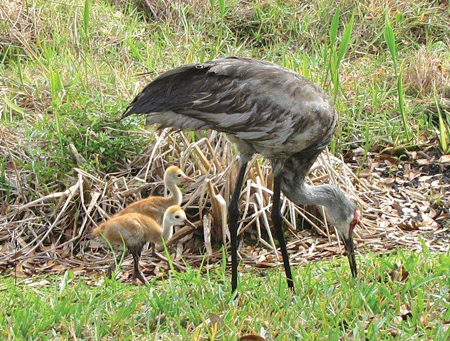Focus on Nature: a delightful day for birders

Since our taxes had been sent in and it was another beautiful day down here in Florida, we decided to go on one of our mini-adventures away from the island that’s become so much a part of us.
We thought we’d try driving out into cattle country, so with a couple of bottles of water, snacks, cameras and binoculars, we were off. As we started out we were surrounded by early morning business traffic with its congestion and rushing cars, but soon we found ourselves in the country, where the pace was more to our liking.
Many years ago parts of Florida were cleared and turned into pastureland where cattle of all kinds — Black Angus, Longhorn, Charolais and others — can be seen today. As we drove the back roads we could see cattle nibbling on what seemed to us like parched earth; evidently they are able to eke some kind of nourishment from it until the next rains come and paint the pasture green.
As we stood watching, we could see white birds feeding around the cattle. A quick check with binoculars revealed tan coloring on the chest and top of the head, which identified them as cattle egrets. From a distance they resembled the white snowy egrets we see in creeks and marshes on the North Fork, but cattle egrets spend their time along roadsides and in pastures, following cattle, horses and even tractors to catch the insects they stir up.
I remember seeing my first cattle egret on Long Island, sometime around 1950. I was in East Moriches with Roy Wilcox, a well-known birder. Since then, the cattle egret has become somewhat common on Long Island. It was native to Africa and Asia and later found in South America. It arrived in Florida in the 1940s and eventually came up our way.
As we drove the country roads, we saw garlands of Spanish moss hanging from the trees. Spanish moss grows on other plants but does not rely on the host plant for nutrients. It makes its own food from rain and particles in the air. We saw great clumps hanging on oak trees. Spanish moss has wiry, curly silver-scaled stems and leaves and tiny seeds that are dispersed by the wind and birds. It was harvested for years as stuffing for furniture and mattresses and today is popular as mulch and is used by the floral industry to hold moisture in floral arrangements.
Every once in a while we’d find a shady spot under a tree to pull off and get out of the car. Almost always we’d hear a mockingbird mocking other birds’ calls. It seems they have found a spot in almost everyone’s backyard. We have them at home on Long Island, where they have done quite well. They usually find a berry tree, like a holly or Russian olive, claim it for themselves and fight off anyone who intrudes. This cache of berries, whether frozen or dried, will see Mr. and Mrs. Mockingbird through harsh winter months.
As we walked around we spotted a dozen vultures held in a thermal’s upheaval. As they circled they reminded me of scenes from old westerns where some poor soul had met his maker and the vultures were starting to move in. Round and round they went, hardly moving their wings; one never tires of watching these gliders in the sky.
On our way back we decided to drive down Creekwood Boulevard, where we’d heard there was a pair of sandhill cranes with two young. And, sure enough, after we pulled up to the municipal pond, it didn’t take five minutes for us to spot the family probing in the soft mud.
How interesting to see the contrast in size between the stately, four-foot-tall adults — gray with a splash of red on their forehead — and the small, fuzzy, tan chicks feeding in and around their parents’ long legs. They paid no attention to us or anyone else around, even though the pond was only a short distance from the busy highway.
We were told that later the cranes would go to spend the rest of their day in a large open field. How lucky we were to finally get to see this family up close; we had seen the one that visits the farm fields in Orient a few times, but only at a distance.
We were in no more hurry on to move on than the sandhill cranes. They took their time in the sun, wandering and feeding at the pond’s muddy edge, among purple pickerelweed and tall arrowhead plants with white flowers swaying in the wind. And we just relaxed and watched them.


